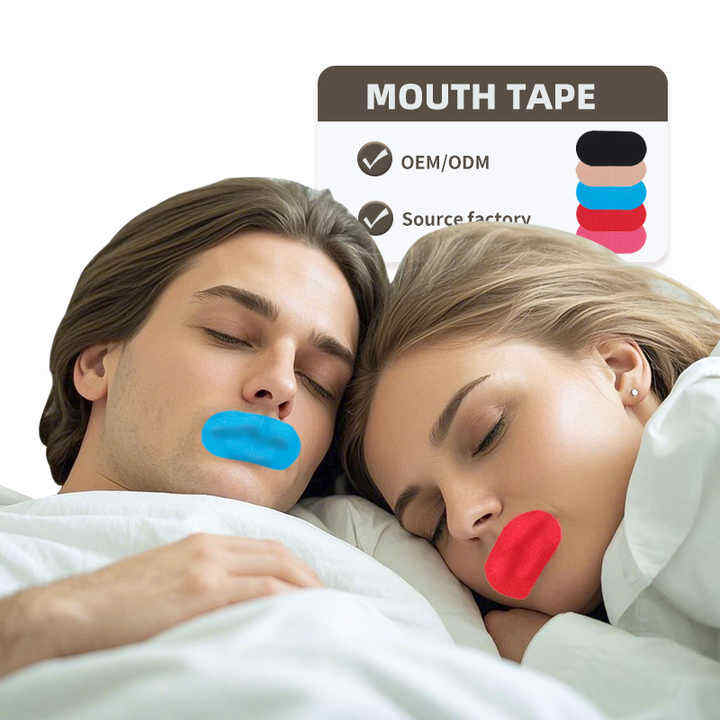How Does Sleep Mouthtape Help With Mouth Breathing Issues
Understanding the Science Behind Sleep Mouth Taping
Sleep mouthtape has emerged as a revolutionary solution for those struggling with mouth breathing during sleep. This simple yet effective tool has gained significant attention in the sleep health community for its ability to promote nasal breathing and improve overall sleep quality. By gently keeping the lips sealed throughout the night, sleep mouthtape encourages proper breathing patterns that can lead to numerous health benefits.
The concept behind sleep mouthtape is rooted in the fundamental principle that nasal breathing is the body's natural and preferred way of respiration. When we breathe through our nose, the air is filtered, humidified, and warmed before reaching our lungs. This process not only protects our respiratory system but also ensures optimal oxygen uptake during sleep.
The Benefits of Using Sleep Mouthtape
Physical Health Improvements
Sleep mouthtape offers numerous physical health advantages that extend beyond just preventing mouth breathing. Users often report reduced snoring, improved oxygen saturation levels, and better morning breath. The practice helps maintain proper moisture levels in the mouth, reducing the risk of dental issues and gum disease.
Additionally, consistent use of sleep mouthtape can help strengthen the muscles around the mouth and throat, potentially reducing the occurrence of sleep apnea symptoms. Many users experience fewer headaches and reduced facial muscle tension after adopting this practice.
Enhanced Sleep Quality
One of the most significant benefits of using sleep mouthtape is the improvement in overall sleep quality. When breathing through the nose, the body naturally produces nitric oxide, a compound that helps optimize oxygen distribution throughout the body. This leads to more restful sleep and increased energy levels during the day.
Users of sleep mouthtape often report falling asleep faster and experiencing fewer nighttime awakenings. The consistent nasal breathing pattern promoted by the tape helps maintain a more stable sleep cycle, resulting in better sleep efficiency.
Proper Application and Usage Techniques
Preparation and Application
Using sleep mouthtape effectively requires proper preparation and application techniques. Before application, ensure your lips are clean and dry. Choose a high-quality, medical-grade tape specifically designed for mouth taping during sleep. These specialized tapes are gentle on the skin and designed to release easily if needed.
Apply the tape horizontally across the lips, ensuring there's enough space for slight lip movement. It's crucial not to tape too tightly, as this could cause discomfort or restrict natural movement. Many users find it helpful to start with small strips and gradually work up to full-mouth coverage as they become more comfortable with the practice.
Safety Considerations
While sleep mouthtape is generally safe, certain precautions should be taken. Always ensure you can breathe comfortably through your nose before applying the tape. If you have nasal congestion or respiratory issues, consult with a healthcare provider before using sleep mouthtape.
It's recommended to start with short periods of use during the day to acclimate to the sensation before using it for full nights of sleep. This gradual approach helps build confidence and ensures a more comfortable transition to nighttime use.
Addressing Common Mouth Breathing Issues
Root Causes of Mouth Breathing
Understanding the underlying causes of mouth breathing is essential for effective treatment. Common factors include nasal obstruction, anatomical issues, allergies, and habitual behavior patterns. Sleep mouthtape can help address these issues by retraining breathing patterns and strengthening oral muscles.
Many people develop mouth breathing habits during childhood or due to chronic nasal congestion. By using sleep mouthtape consistently, these patterns can be reversed, leading to improved breathing habits even during waking hours.

Long-term Solutions
While sleep mouthtape provides immediate benefits, it's most effective as part of a comprehensive approach to addressing mouth breathing issues. This may include working with healthcare providers to address underlying anatomical concerns, implementing proper dental hygiene practices, and maintaining good nasal health.
Regular use of sleep mouthtape can help establish better breathing patterns that persist even when not using the tape. Many users report improved daytime breathing habits after several weeks of consistent nighttime use.
Choosing the Right Sleep Mouthtape
Material Considerations
The effectiveness of sleep mouthtape largely depends on choosing the right product. Look for tapes made from hypoallergenic materials that are specifically designed for use on sensitive facial skin. The adhesive should be strong enough to stay in place throughout the night but gentle enough to remove without causing irritation.
Different brands offer various sizes and styles of sleep mouthtape, from full-width strips to smaller, specially shaped options. Some include breathing holes or unique adhesive patterns to enhance comfort and effectiveness.
Quality and Safety Standards
When selecting sleep mouthtape, prioritize products that meet medical-grade standards and have been tested for safety. Look for certifications and positive user reviews that indicate consistent quality and reliability. The best options will come from reputable manufacturers who specialize in sleep or medical products.
Consider the tape's breathability and moisture-resistance capabilities, as these features contribute to comfort and effectiveness during sleep. Some products offer additional benefits like enhanced adhesion or skin-nourishing properties.
Frequently Asked Questions
Is sleep mouthtape safe for long-term use?
Yes, sleep mouthtape is generally safe for long-term use when properly applied and used as directed. However, it's important to use medical-grade tape designed specifically for this purpose and to consult with a healthcare provider if you have any underlying health conditions.
How long does it take to see results from using sleep mouthtape?
Most users report noticeable improvements in sleep quality and breathing patterns within the first few weeks of consistent use. However, individual results may vary, and some people experience benefits immediately while others may take longer to adjust and see significant changes.
Can children use sleep mouthtape?
Sleep mouthtape use in children should only be undertaken under the guidance of a healthcare provider. While it can be beneficial for addressing mouth breathing issues in children, proper supervision and assessment of underlying causes are essential for safe and effective use.
What should I do if I have nasal congestion while using sleep mouthtape?
If you experience nasal congestion, it's recommended to address the congestion before using sleep mouthtape. This may include using nasal strips, saline sprays, or other appropriate treatments. Never use sleep mouthtape if you're unable to breathe comfortably through your nose.



